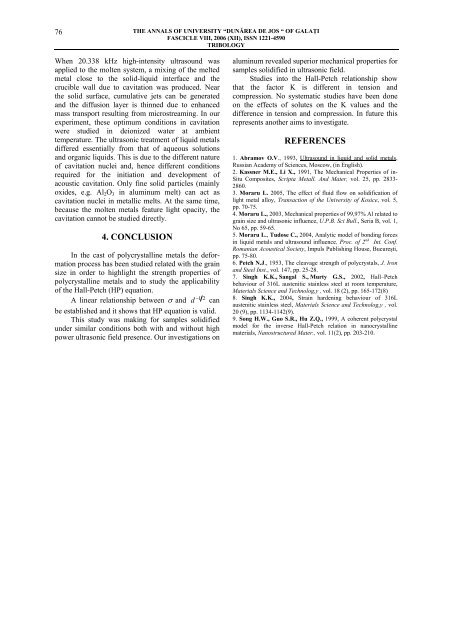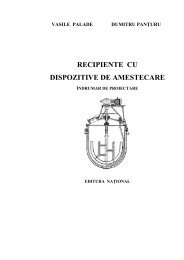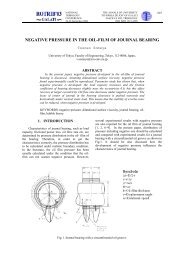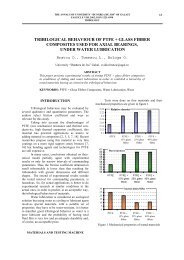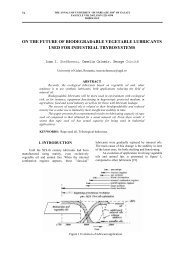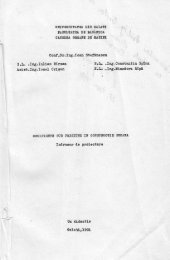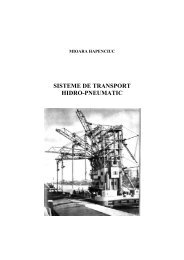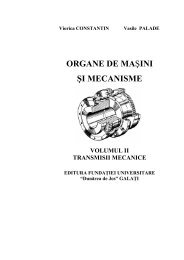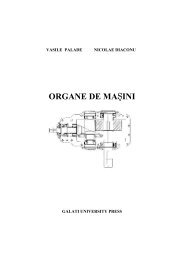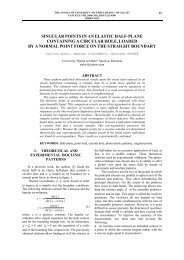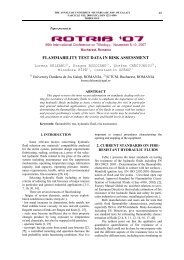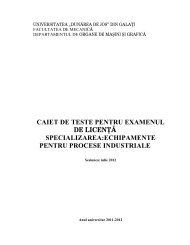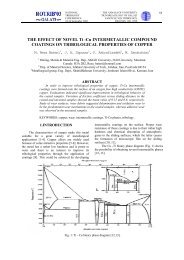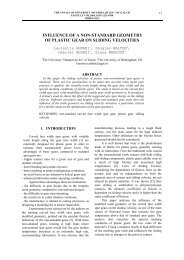ultrasound action on strength properties of polycrystalline metals
ultrasound action on strength properties of polycrystalline metals
ultrasound action on strength properties of polycrystalline metals
You also want an ePaper? Increase the reach of your titles
YUMPU automatically turns print PDFs into web optimized ePapers that Google loves.
76<br />
THE ANNALS OF UNIVERSITY “DUNĂREA DE JOS “ OF GALAŢI<br />
FASCICLE VIII, 2006 (XII), ISSN 1221-4590<br />
TRIBOLOGY<br />
When 20.338 kHz high-intensity <str<strong>on</strong>g>ultrasound</str<strong>on</strong>g> was<br />
applied to the molten system, a mixing <strong>of</strong> the melted<br />
metal close to the solid-liquid interface and the<br />
crucible wall due to cavitati<strong>on</strong> was produced. Near<br />
the solid surface, cumulative jets can be generated<br />
and the diffusi<strong>on</strong> layer is thinned due to enhanced<br />
mass transport resulting from microstreaming. In our<br />
experiment, these optimum c<strong>on</strong>diti<strong>on</strong>s in cavitati<strong>on</strong><br />
were studied in dei<strong>on</strong>ized water at ambient<br />
temperature. The ultras<strong>on</strong>ic treatment <strong>of</strong> liquid <strong>metals</strong><br />
differed essentially from that <strong>of</strong> aqueous soluti<strong>on</strong>s<br />
and organic liquids. This is due to the different nature<br />
<strong>of</strong> cavitati<strong>on</strong> nuclei and, hence different c<strong>on</strong>diti<strong>on</strong>s<br />
required for the initiati<strong>on</strong> and development <strong>of</strong><br />
acoustic cavitati<strong>on</strong>. Only fine solid particles (mainly<br />
oxides, e.g. Al 2 O 3 in aluminum melt) can act as<br />
cavitati<strong>on</strong> nuclei in metallic melts. At the same time,<br />
because the molten <strong>metals</strong> feature light opacity, the<br />
cavitati<strong>on</strong> cannot be studied directly.<br />
4. CONCLUSION<br />
In the cast <strong>of</strong> <strong>polycrystalline</strong> <strong>metals</strong> the deformati<strong>on</strong><br />
process has been studied related with the grain<br />
size in order to highlight the <strong>strength</strong> <strong>properties</strong> <strong>of</strong><br />
<strong>polycrystalline</strong> <strong>metals</strong> and to study the applicability<br />
<strong>of</strong> the Hall-Petch (HP) equati<strong>on</strong>.<br />
A linear relati<strong>on</strong>ship between σ and d<br />
−1 2<br />
can<br />
be established and it shows that HP equati<strong>on</strong> is valid.<br />
This study was making for samples solidified<br />
under similar c<strong>on</strong>diti<strong>on</strong>s both with and without high<br />
power ultras<strong>on</strong>ic field presence. Our investigati<strong>on</strong>s <strong>on</strong><br />
aluminum revealed superior mechanical <strong>properties</strong> for<br />
samples solidified in ultras<strong>on</strong>ic field.<br />
Studies into the Hall-Petch relati<strong>on</strong>ship show<br />
that the factor K is different in tensi<strong>on</strong> and<br />
compressi<strong>on</strong>. No systematic studies have been d<strong>on</strong>e<br />
<strong>on</strong> the effects <strong>of</strong> solutes <strong>on</strong> the K values and the<br />
difference in tensi<strong>on</strong> and compressi<strong>on</strong>. In future this<br />
represents another aims to investigate.<br />
REFERENCES<br />
1. Abramov O.V., 1993, Ultrasound in liquid and solid <strong>metals</strong>,<br />
Russian Academy <strong>of</strong> Sciences, Moscow, (in English).<br />
2. Kassner M.E., Li X., 1991, The Mechanical Properties <strong>of</strong> in-<br />
Situ Composites, Scripta Metall. And Mater, vol. 25, pp. 2833-<br />
2860.<br />
3. Moraru L. 2005, The effect <strong>of</strong> fluid flow <strong>on</strong> solidificati<strong>on</strong> <strong>of</strong><br />
light metal alloy, Trans<str<strong>on</strong>g>acti<strong>on</strong></str<strong>on</strong>g> <strong>of</strong> the University <strong>of</strong> Kosice, vol. 5,<br />
pp. 70-75.<br />
4. Moraru L., 2003, Mechanical <strong>properties</strong> <strong>of</strong> 99,97% Al related to<br />
grain size and ultras<strong>on</strong>ic influence, U.P.B. Sci Bull., Seria B, vol. 1,<br />
No 65, pp. 59-65.<br />
5. Moraru L., Tudose C., 2004, Analytic model <strong>of</strong> b<strong>on</strong>ding forces<br />
in liquid <strong>metals</strong> and <str<strong>on</strong>g>ultrasound</str<strong>on</strong>g> influence, Proc. <strong>of</strong> 2 nd Int. C<strong>on</strong>f.<br />
Romanian Acoustical Society, Impuls Publishing House, Bucureşti,<br />
pp. 75-80.<br />
6. Petch N.J., 1953, The cleavage <strong>strength</strong> <strong>of</strong> polycrystals, J. Ir<strong>on</strong><br />
and Steel Inst., vol. 147, pp. 25-28.<br />
7. Singh K.K., Sangal S., Murty G.S., 2002, Hall–Petch<br />
behaviour <strong>of</strong> 316L austenitic stainless steel at room temperature,<br />
Materials Science and Technolog,y , vol. 18 (2), pp. 165-172(8)<br />
8. Singh K.K., 2004, Strain hardening behaviour <strong>of</strong> 316L<br />
austenitic stainless steel, Materials Science and Technolog,y , vol.<br />
20 (9), pp. 1134-1142(9).<br />
9. S<strong>on</strong>g H.W., Guo S.R., Hu Z.Q., 1999, A coherent polycrystal<br />
model for the inverse Hall-Petch relati<strong>on</strong> in nanocrystalline<br />
materials, Nanostructured Mater., vol. 11(2), pp. 203-210.


